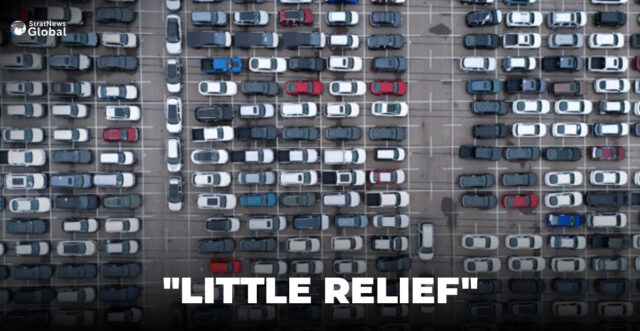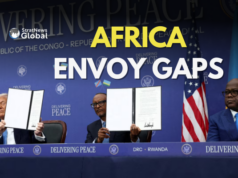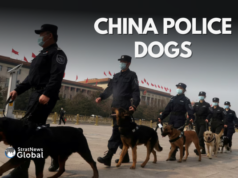On Tuesday, U.S. President Donald Trump signed two orders aimed at easing the impact of his auto tariffs, offering a combination of tax credits and relief from other material-related levies. At the same time, his trade team announced its first agreement with a foreign trading partner — moves that helped calm investor concerns over the unpredictability of Trump’s trade policies.
The change comes the day Trump arrived in Michigan, cradle of the U.S. auto industry and just days before a fresh set of 25% import taxes was set to kick in on automotive components. The trip, on the eve of his 100th day in office, comes as Americans take an increasingly dim view of Trump’s economic stewardship, with indications his tariffs will weigh on growth and could drive up inflation and unemployment.
‘Little Relief’
In his latest partial reversal of tariff policies, the Republican president agreed to provide carmakers with credits for up to 15% of the value of vehicles assembled domestically. These could be applied against the value of imported parts, allowing time to bring supply chains back home.
Auto industry leaders had lobbied the administration furiously during the weeks since Trump first unveiled his 25% tariffs on imported vehicles and auto parts. The levies, aimed at forcing automakers to reshore manufacturing domestically, had threatened to scramble a North American automotive production network integrated across the U.S., Canada and Mexico.
It offers the industry a “little relief” as companies invest in more U.S. production, Trump said as he left Washington for Michigan. “We just wanted to help them … if they can’t get parts, we didn’t want to penalize them.”
25% Tariff Remains
The White House noted the move does not soften the 25% tariffs imposed last month on the 8 million vehicles the United States imports annually.
Autos Drive America, a group representing Toyota Motor, Volkswagen, Hyundai and nine other foreign automakers, said Trump’s order provided some relief “but more must be done in order to turbocharge the U.S. auto industry.”
The uncertainty unleashed across the auto sector by Trump’s tariffs remained on full display Tuesday when GM pulled its annual forecast even as it reported strong quarterly sales and profit. In an unusual move, the carmaker also opted to delay a scheduled conference call with analysts until later in the week, after the details of tariff changes were known.
‘Deal Done’
Meanwhile, U.S. Commerce Secretary Howard Lutnick told CNBC he had reached one deal with a foreign power that should permanently ease the “reciprocal” tariffs Trump plans to impose. Lutnick declined to identify the country, saying the deal was pending local approvals.
“I have a deal done … but I need to wait for their prime minister and their parliament to give its approval,” Lutnick said.
Lutnick’s comments helped further lift stock prices that had been battered by Trump’s moves to reshape global trade and force goods makers to shift production to the U.S. The benchmark S&P 500 Index closed 0.6% higher for a sixth day of gains, its longest streak of gains since November.
Waning Approval
Trump and his team aim to strike 90 trade deals during a 90-day pause on his reciprocal tariffs announced earlier in April. His administration has repeatedly said it was negotiating bilateral trade deals with dozens of countries.
A chief Trump goal is to bring down a massive U.S. goods trade deficit, which shot to a record in March on a surge of imports aimed at front-running the levies.
Trump’s aggressive trade policies have cascaded through the global economy since his return to the White House in January, and the 90-day pause was announced after financial markets went into a tailspin over fears of recession and inflation, among other factors.
Softening the impact of auto levies is his administration’s latest move to show flexibility on tariffs which have sown turmoil in financial markets, created uncertainty for businesses and sparked fears of a sharp economic slowdown. A Reuters/Ipsos poll published Tuesday showed just 36% of respondents approve of his economic stewardship, the lowest level in his current term or in his 2017-2021 presidency.
Meanwhile, the first quarterly report on U.S. gross domestic product covering Trump’s term is due out on Wednesday. It is expected to reflect a large drag from the effect of his tariffs, mostly from a record surge in imports as companies and consumers front-loaded purchases of foreign goods to try to beat the new levies. The economy was forecast to have expanded at just a 0.3% annualized rate from January through March, according to a Reuters poll of economists, down from 2.4% in the final three months of 2024.
Companies Sound Alarm
American and global companies are increasingly sounding the alarm about the tariffs’ effects.
UPS on Tuesday said it would cut 20,000 jobs to lower costs, while General Motors pulled its outlook and pushed its investor call to Thursday pending possible changes to trade policy. Also citing tariffs headwinds were American ketchup maker Kraft Heinz and Swedish appliances maker Electrolux, further evidence that a chaotic trade policy is taking a major toll on companies’ ability to plan beyond the immediate term.
About 40 companies worldwide have pulled or lowered their forward guidance in the first two weeks of first-quarter earnings season, a Reuters analysis showed.
“Every single prediction has been proved to be wrong,” Yannick Fierling, Electrolux CEO, told Reuters. “I’m surprised if people are claiming they have a view where tariffs are going.”
(With inputs from Reuters)





